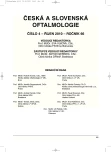The Embedded Mobile Orbital Implant from Methylmethacrylate „Hydron“ – Clinical and Histopathological Findings 25 Years after Implantation
Authors:
A. Furdová 1; Z. Oláh 1; Z. Svetlošáková 1; P. Babál 2; D. Kobzová 2
Authors‘ workplace:
Klinika oftalmológie LFUK a UNB, Bratislava, prednosta prof. MUDr. Strmeň Peter, CSc.
1; Ústav patologickej anatómie LFUK, Bratislava, vedúci prof. MUDr. Ľudovít Danihel, Ph. D.
2
Published in:
Čes. a slov. Oftal., 66, 2010, No. 4, p. 180-183
Category:
Original Article
Overview
The embedded mobile hydrogel methylmethacrylate („HYDRON“ Spofa) orbital implants introduced in the beginning of 70th years of 20th century was a new method to get good cosmetic effects after enucleation. At the Dept. of Ophthalmology of the Comenius University, Bratislava, the rejection rate of this type of orbital implants in the first years after enucleation (1971–1974) was only 16.8%. This technique was applied in patients after enucleation due to traumatic phtisis of the eye globe. Authors submit a case report of a female patient from the group of implanted mobile orbital implant HYDRON implanted in 1984. They analyze clinical features and histopathological findings after surgical removement 25 years after implantation.
Key words:
mobile orbital implants after enucleation, embedded mobile orbital implant from methylmethacrylate
Sources
1. Arruga, K.: Problem of orbital Implants after enucleation. Brit J Ophthalm., 41, 1956; 2: 313–315.
2. Dreifus, M., Herben, T., Lim, D., et al.: Tolerance orbitálních implantátů z hydrokoloidního akrylátu. Sborník lék., 62, 1960; 7–8: 212–218.
3. Gerinec, A., Slivková, D.: Orbitálne implantáty u detí. Choroby hlavy a krku, 2, 1997; 6: 5–9.
4. Hicks, CR., Morrison, D., Lou, X, et al.: Orbital implants: potential new directions. Expert Rev Med Devices, 2006; 3(6): 805–815.
5. Jordan, DR.: Operative Techniques in Oculoplastic, Orbital and Reconstructive Surgery, 2001; 1(4): 39-47.
6. Jordan, DR., Klapper, SR., Gilberg, SM., et al.: The bioceramic implant: evaluation of implant exposures in 419 implants. Ophthalmic plastic and reconstructive surgery, 2010; 26(2): 80–82.
7. Jordan, DR., Klapper, SR., Mawn, L., et al.: Abscess formation within a synthetic hydroxyapatite orbital implant. Canadian journal of ophthalmology. Journal canadien d’ophtalmologie, 1998; 33(6): 329–32.
8. Mawn, LA., Jordan, DR., Gilberg, S.: Scanning electron microscopic examination of porous orbital implants. Canadian journal of ophthalmology. Journal canadien d’ophtalmologie, 1998;33(4): 203–209.
9. Norda, AG., Meyer-Russenberg, HW.: Experience with orbital implants in particular with porous hydroxyapatite materials. Ophthalmologe, 2003; 100(6): 435–436.
10. Oláh, Z.: Skúsenosti s pohyblivou náhradou bulbu hydrofilným gélom methylmetakrylátu “HYDRON”. Čs. Oftalm., 31, 1975; 3: 180–183.
11. Oláh, Z., Gundorova, A., Katajev, M.G., et al.: Porovnanie efektívnosti pohyblivej protézy vytvorenej implantáciou “HYDRON”-u a chrupavky po enukleácii bulbu. Čs. Oftal., 46, 1990; 3: 161–165.
12. Perry, AC.: Advances in enucleation. Ophthal Plast Reconstr Surg, 1991; 4: 173-182.
13. Perry, AC.: Integrated orbital implants. In Bosniak SL, Smith BC (eds): Advances in ophthalmic, plastic, and reconstructive surgery, vol 8. New York, Pergamon Press 1990; 75 s.
14. Perry, AC.: When to drill the biomatrix hydroxyapatite ocular implant. J Am Soc Ocularists, 1991; 22: 5–7.
15. Soll, DB.: Enucleation Surgical Techniques and the Management of Complications. In: Schachat AP., Jampel HD., McDonnel PJ., Sternberg P. Jr., Miller NJ.: Current Practice in Ophthalmology. Mosby Year Book, St. Louis-Baltimore-Chicago-London-Philadelphia-Sydney-Toronto. 1992, 402 s.
16. Soll, DB.: Evolution and current concepts in the surgical treatment of the anophthalmic orbit. In Smith BC, Della Rocca RC, Nesi FA, et al (eds): Ophthalmic Plastic and Reconstructive Surgery, vol 2. St. Louis, CV Mosby 1987; 1321 s.
17. Šif, LV.: Glaznoje protezirovanije. Medicina, Moskva, 1981, 136 s.
18. Yeatts, PR., Grim, V., Stanton, C., et al.: Injectable hydroxyapatite paste as an option for ocular implantation after evisceration. Ophthalmology, 2002; 11: 2123–2128.
Labels
OphthalmologyArticle was published in
Czech and Slovak Ophthalmology

2010 Issue 4
Most read in this issue
- Non Arteriitic Anterior Ischemic Optic Neuropathy in Optic Nerve Drusen – A Case Report
- The Diagnostics of Tapetoretinal Dystrophies Using Electrophysiological Methods
- Basalioma of the Eyelid: Rate and Factors of Recurrence after Surgical Therapy
- The Embedded Mobile Orbital Implant from Methylmethacrylate „Hydron“ – Clinical and Histopathological Findings 25 Years after Implantation
